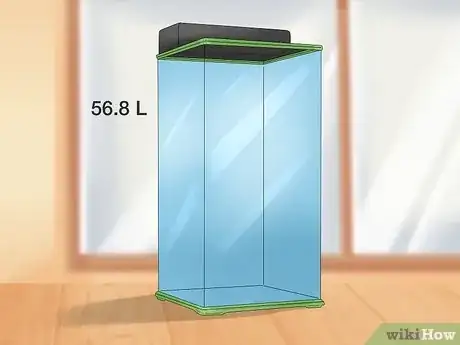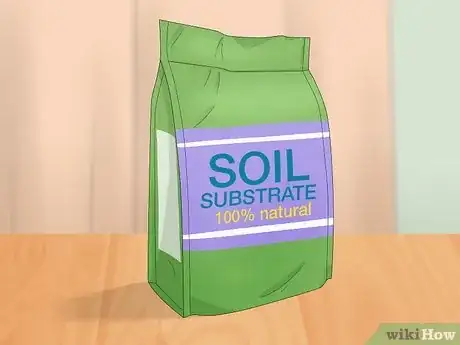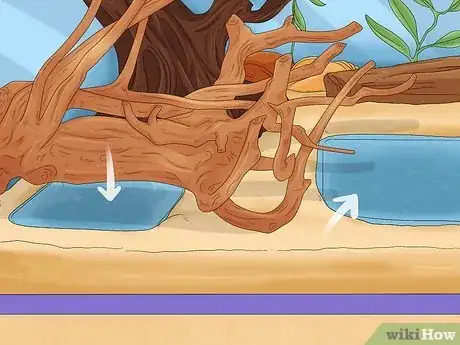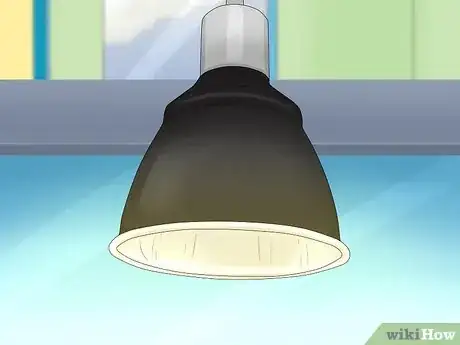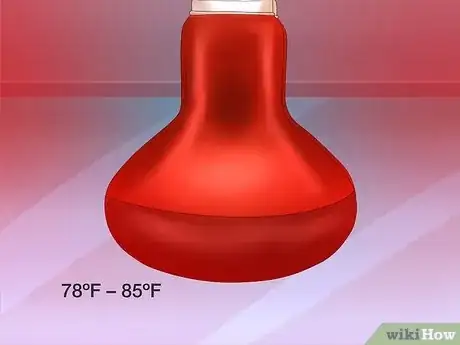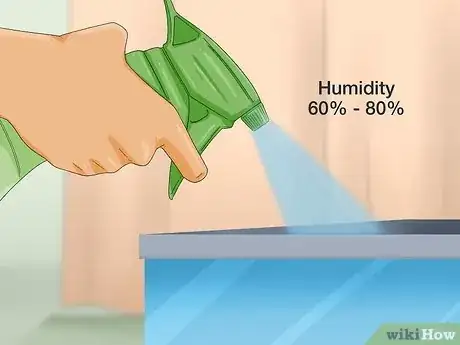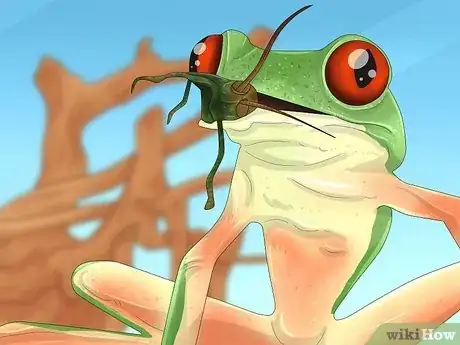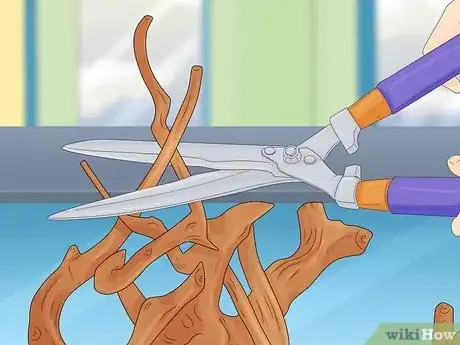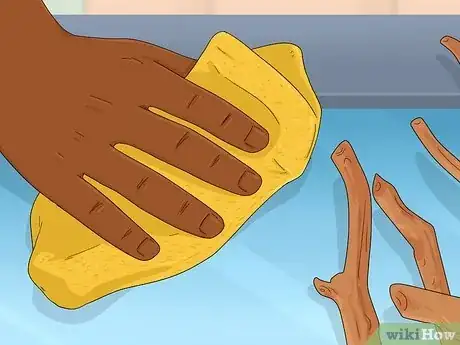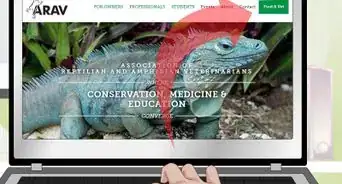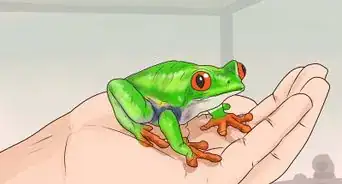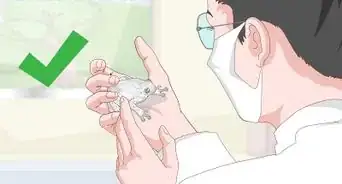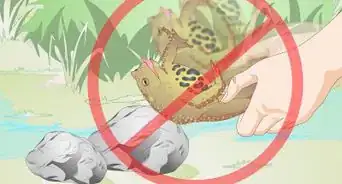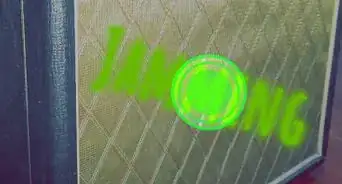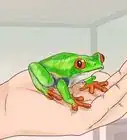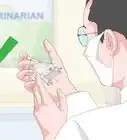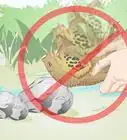X
wikiHow is a “wiki,” similar to Wikipedia, which means that many of our articles are co-written by multiple authors. To create this article, 13 people, some anonymous, worked to edit and improve it over time.
This article has been viewed 31,793 times.
Learn more...
Setting up a frog enclosure takes a little time to do correctly, but is more than worth the time when you consider the fact that if it's done correctly the first time, all future enclosure-related issues will be much easier to deal with. Not to mention the fact that the more appropriate the enclosure is to the frog's needs, the happier and healthier the animal(s) will be.
Steps
-
1Purchase a suitable enclosure. Red eyed tree frogs are arboreal animals. This means that they spend most of their time in trees and tall plants. Keeping this fact in mind, you should always try to get as tall an aquarium as is reasonably possible. This leaves much to speculation, but as a rule of thumb you should have 15 gallons (56.8 L) or 20" x 10" x 17" worth of enclosure per adult red eyed tree frog.
- The enclosure should have limited screen openings as this will make it very challenging to keep up the 80-90% humidity level these frogs require. Either a removable or liftable screen/mesh top will work fine. That is based upon your preference. You can have both. Glass sides, as opposed to screen and/or mesh make it easier not only for the frogs to climb on but also to keep the humidity up.
-
2Add substrate to the bottom of the enclosure. Substrate, or ground covering, is important as it helps to make not only the cleaning process easier, but it helps with the aesthetics, humidity control and excrement collection. It can, depending upon the type used, also be used for live plants. There are many different ways to cover the floor of the enclosure.[1]
- Paper towel: These are great for easy clean up during enclosure maintenance, while also being cheap and easy to replace. The downside is paper towels don't hold moisture for long and tends to build up bacteria and smell quicker. It also looks very clinical and sterile, if you're concerned about aesthetics.
- Moss: Moss holds moisture pretty well and is easy to distribute along the floor. If the moss is live, it also consumes excrement and grows. However, moss tends to be messy, sticks to frogs (not in a bad way, just tends to get cluttered on their skin), can have a pungent odor, and dirties the water. It also makes an excellent hiding place for any insects that escaped feeding.
- Soil: Soil will hold moisture for extended periods of time, looks natural, works well with or without live or dried moss and has a nice earthy aroma. Unfortunately, it is messy, dirties the frogs and water, and can house fungus and mold, if not controlled. Soil can be a bit pricier than other options, if you get coconut husk or tropical soil bricks.
Advertisement -
3Decorate with branches or other climbing surfaces. These tree frogs are an arboreal species, meaning that in the wild they spend a lot of time in trees. It's important to replicate that sort of environment in your enclosure by adding places for your frogs to climb.
- Bendable branches are great for altering the look and feel of the environment to your liking each time you clean. They are not too inexpensive, but you can usually find them on Craigslist for cheap. They are also softer and don't come with the risk of scratching, scarring or tearing the frog's delicate skin.
- Driftwood is also a nice touch, but tends to gather mold quickly and rots easily in the high humidity environment of the tree frog enclosure.
- African driftwood, or Mopani wood, is a great option as it hinders mold and mildew growth. It's also heavy, so it won't tip or fall once properly secured. However, it can be expensive. Be sure to check for sharp edges and sand them down to keep your frogs safe.
-
4Add water to the habitat. Like every creature, frogs need water to survive. A shallow dish of water should be provided at all times, though you can add more complex water features, like waterfalls or streams, if desired. Add large, smooth rocks to water containers to allow the frogs to exit easily. Be sure none of the water in their enclosure is too deep. They may be frogs, but red-eyed tree frogs are not especially strong swimmers.
- Streams and pools typically accompany the waterfall or moving water feature. These are also harder to maintain and clean; not to mention they are typically costly additions.
- Always use dechlorinated water, but avoid distilled water.[2] Clean and replace the water every day. They muck the water up quickly as frogs find it easier to eliminate their bowels (poop) in water.
-
5Consider what lighting to use. Red eyed tree frogs aren't particular as to which type of lighting is used. Lights should be kept on for 12 hours, with 12 hours off to simulate a natural day/night cycle. If you have live plants in your enclosure then you'll need a UV grow light set at a 12 hour time limit or the plants will decay. Consider using a timer for convenience and to keep the amount of light consistent.
- Steer clear of incandescent lighting as it is too hot and doesn't last nearly as long as UV. It's also more wasteful for the environment.
-
6Maintain the correct temperature. Red-eyed tree frogs need a temperature between 78ºf – 85ºf (26ºc - 29ºc). At night, the temperature can drop, but by no more than ten degrees. You might be able to maintain this temperature at home with no supplemental heating, but consider adding a heating pad beneath the enclosure or a low-wattage heat bulb. These warm up the enclosure without effecting the humidity much.[3] A nocturnal heat bulb is a good choice as these can be kept on during the night as well.
-
7Keep the humidity between 60% - 80%. Tree frogs need a moist environment to stay healthy, but too much moisture can be dangerous as well.[4] Spraying the enclosure with water twice a day is suitable for most setups. You can use a spray bottle to do this manually, but there are also automated misting systems available. Adding water features can also help keep the humidity up, even something as simple as a water dish.
-
8Feed your frogs a balanced diet. Red eyed tree frogs love to eat. Like most all frogs, they are gluttons. Meaning they will eat until they develop a weight problem. Nothing is sadder than to watch an obese frog try to nimbly climb or jump. The food of choice is of course crickets. The size of all their live food should be no longer that the width of the frog's head from eye to eye. This measurement is cast aside if feeding a red wiggler worm or wax worms. The frog fodder list goes as follows – but is in no particular order:
- Crickets
- Dubia cockroaches
- Wax worms
- Red wiggler earth worms
- Flies
- Moths
- Other soft bodied insects.
-
9Inspect the enclosure daily. Be sure to check on your frog's enclosure daily and remove any noticeable waste. Trim dead leaves from plants and remove any excrement or dead, uneaten bugs. Clean out their water dish and replace with fresh water. Make sure all your branches or other decor is looking clean and hasn't been knocked over. This is also a good time to inspect the frogs for injuries and general health conditions.
-
10Fully clean your enclosure every two weeks. Every two weeks you should perform a deep clean on the enclosure. Using a reptile safe cleaner, spray the walls of the enclosure. After spraying down and wiping off all the walls, be sure to go over the walls again with a clean damp towel or cloth, just to make sure. You should smell only humidity and/or soil/moss. Any hint of a chemical spray is too much residue and should be removed. Amphibians absorb chemicals through their skin. So think of any chemicals left behind as being injected directly into your veins. This would be bad.
- Do not use household cleaners. These will leave a poisonous residue and will kill your frogs. All pet stores sell reptile cleaning sprays designed to be used safely on all reptile and amphibian enclosures.
- Remove and replace old substrate. If using a planted soil-based substrate, shave off the top layers and replace with new soil as needed.
Advertisement
Community Q&A
-
QuestionIs this the same with all tree frogs?
 Community AnswerDifferent animals need different enclosures, so it depends on the tree frog you're getting.
Community AnswerDifferent animals need different enclosures, so it depends on the tree frog you're getting. -
QuestionHow do I heat the enclosure?
 Community AnswerThere are light bulbs that provide heat. They have many varieties, ask someone at the pet store which one will best suit your needs.
Community AnswerThere are light bulbs that provide heat. They have many varieties, ask someone at the pet store which one will best suit your needs. -
QuestionIsn't having a red-eyed tree frog illegal because they are endangered?
 Community AnswerYes.
Community AnswerYes.
Advertisement
Warnings
- Do not feed from your garden or around your house. These insects are not clean and may be subjected to poisons and herbicides. The typical insect poison is designed to kill all ectotherms (animals who cannot control their own temperature). Frogs, all amphibians for that matter, are ectotherms. If it will kill an insect, it will kill a frog.⧼thumbs_response⧽
- Always wash your hands before and after touching the frog. If you don't it could kill the frog.⧼thumbs_response⧽
Advertisement
References
- ↑ https://www.joshsfrogs.com/catalog/blog/2018/06/red-eye-tree-frog-captive-bred-agalychnis-callidryas/
- ↑ http://www.exoticpetvet.com/red-eyed-tree-frog-care.html
- ↑ https://www.lllreptile.com/articles/116-red-eyed-tree-frogs/
- ↑ https://amccorona.com/wp-content/uploads/2020/05/ARAV_trifold_RedEyedTreeFrog_1-19-18.pdf
About This Article
Advertisement
